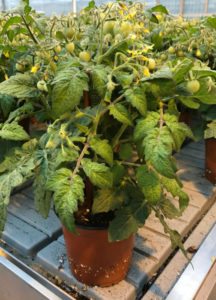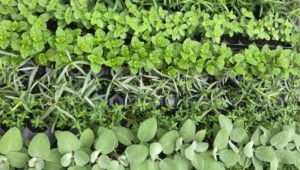
Safe Edible Production
What does “safe” edible production mean, anyway? I think we all want to believe that we are producing edibles safe to eat. I think that if you would ask a consumer, they would say “safe” means pesticide free. In contrast, most growers would say that safe edibles also include plants grown using pesticides for edibles used following labeled requirements.
Recently, there is an interesting shift of consumers from a preference for “organic” edibles, and toward “locally produced” or “pesticide free.” Pesticide-free edibles can be easier to produce than organic edibles as we can use traditional fertilizers rather than organic fertilizers which can be expensive and can be challenging to apply.
Regardless, producing either organic or pesticide-free edibles crops has become easier in recent years. Organic edible producers now have a number of OMRI-registered pesticides available, as well as new organic fertilizers. Pesticide-free producers now have many biocontrol options available as well as new non-pesticide materials they can spray to manage pests and diseases.
Non-chemical Production Techniques

Height control. Growers manage edible crop stem elongation and height primarily by managing media moisture and fertility, day/night temperature and light amount and color.
Growing plants constantly moist will result in more stem elongation than if plants are periodically dried down. Interestingly, herb flavor can also be enhanced by periodic drought stressing plants.
Growing plants with a low EC (0.5 to 0.75; 2:1 test) results in less elongation than growing with a high EC. Aside from EC, growers should use a fertilizer with a high proportion of the nitrogen in the nitrate form versus ammonium/urea form; high ammonium/urea promotes stem elongation.
Stem elongation is greatly affected by day/night temperature. Try to 1) drop day temperatures 7 to 10° F from 6 a.m. to 9:00 a.m., and minimize the difference between day and night temperature (large DIF) in general.
Light intensity and color affect stem elongation. Specifically, providing bright light (> 2,000 foot-candles; > 400 μmol m⁻² s⁻¹) will help control elongation and, if supplemental lighting is used, make sure that the red:far-red ratio of the lights is greater than 1.1. New LEDs can have high red:far-red ratios that can greatly reduce stem elongation.
Disease management. Managing diseases is all about water management, limiting touching and preventative biological sprays. For instance, Botrytis spores germinate when leaf surfaces are moist for more than four hours. In contrast to Botrytis, bacteria are spread by contact. That contact can occur when staff are planting liners/ cuttings or when cleaning foliage. Contact can also occur when plants grow together on a bench and when overhead watering results in splashing between leaves on a plant and among plants.
These practices are generally good procedures to limit disease outbreaks:
- Don’t water any time when leaves will remain wet for more than four hours. This includes during the shipping process!
- Consider growing with flood benches or drip tubes/tape that minimize foliage wetting.
- Spray liners with a bactericide the day before transplanting.
- Periodic cleaning should involve staff washing/sterilizing their hands and equipment (i.e., alcohol, Zerotol, Sanidate).
- Minimize dead foliage in the greenhouse — a source of those spores.
- Periodic fungicide sprays.
Pest Management. The best way to control pests when attempting to grow an organic or pesticide-free edible crop is to exclude them. Exclude pests by installing thrip screen on vents; this practice is very important! Also, do not allow employees to walk into infested greenhouses and then transport those pests to a clean greenhouse on their clothing; most growers use overalls to address this issue.
Should pests get in a greenhouse, the best way to control them in an edible crop is with biologicals. However, in every case I have seen, biologicals are only successful when applied before pests are seen. Growers should introduce biologicals on a regular basis or raise their own on “banker” plants. I will not elaborate on biological control more here; growers should refer to the many great articles written by Ray Cloyd at Kansas State University on this topic.
Chemical Options
Fortunately, there are a number of OMRI-registered pesticides that can be used on edibles. Some especially good for disease control include Zerotol (1 or 2), Cease and Micora. With respect to pesticides, biologicals should be your first option. If a chemical control is necessary, some registered materials for greens growers have reported good results with Pyrethrum, Kontos (see label), oils (low rates) and Acephate 97. Fruiting edibles have a much broader group of pesticides registered for use. Throughout, remember to always follow the label!
There are also a number of pesticides and plant growth regulators registered for edible crop application that are not OMRI registered. For instance, Sumagic is registered for use on tomatoes, eggplant and peppers for height control, but is not OMRI approved. I suggest if any chemical is used that it is applied early in production to minimize biological activity at the end of a crop to ensure consumers will have no adverse effects. Of course, at a minimum, follow the guidelines on the label.
With either fungicides or pesticides we have noticed that addition of any horticultural oils can increase efficacy (low rate). Also, for thrips, Captiva has been very helpful to agitate thrips to increase efficacy of pesticides for thrip control; the only problem is that it smells!

New Techniques
Cutting dips and seed soaks. Cuttings/seed can be dipped in Zerotol or Sanidate to “sterilize” them prior to sticking/sowing. This ensures you start with clean, disease-free plant material. In general, we have found that a 30- to 60-minute dip/soak works best. Always make sure dips do not burn liners by trialing a small batch first.
Alternatively, growers can dip cuttings in a solution that contains biologicals for disease and/or pest control such as Cease and/or horticultural oils (low rate), respectively, prior to sticking. This was recently shown to be quite effective in Canada.
Constant pest/disease suppression. An alternative way to manage pests and diseases is to apply preventative pest/disease control sprays on a weekly basis to provide a constant low level of control to make it hard for any disease/pest to establish itself. I highly recommend this option. Typical materials for disease control include Cease, Zerotol (not compatible when using fungi/bacteria for control as well, such as Cease or referal/BioCeres), or copper-based fungicides. Possible OMRI listed options for pest control include Botaniguard MAXX (not OMRI listed), SuffOil-X, Preferal and BioCeres WP among others.
Calcium sprays. Salt sprays (calcium nitrate or calcium chloride) can reduce disease incidence (particularly Botrytis; see great work by Jim Faust at Clemson University) and stem elongation. In general, spray with 800- to 1,200-ppm calcium nitrate plus a surfactant (usually Capsil).
Root biome management. Recent research we and others are conducting shows that addition of microorganisms to the media can decrease the susceptibility of roots to death due to pot heating, or from root rot diseases. Also, we suspect that some of these materials increase nutrient uptake, which is especially helpful when using organic fertilizers which generally have lower nutrient levels.
Touching to reduce elongation. Interestingly, plant height can be reduced by touching. We (Tammy Van Gaal and I) determined that that touching must occur early in the morning. Touching in the late morning or during the afternoon has no effect.
Special Considerations
Nitrate levels. High tissue nitrate levels have been associated with cancer. The EU food safety standard for tissue nitrate levels in 3,000 ppm. Some field produced lettuce in the U.S. has been shown to have nitrate levels that exceed the EU safety standard. I think this is an opportunity for greenhouse producers that can manage foliar nitrate levels to insure they are below 3,000 ppm year round.
Pre-ship foliage sterilization. Spray application of Zerotol or other sterilizing agent to ensure no E. coli is present on foliage is a critical step. Greenhouse tomato and pepper growers routinely wash fruit in a solution that sterilizes the exterior. In my opinion, greenhouse greens growers should follow a similar strategy to be safe.
Acknowledgements. We greatly appreciate the financial support of the USDA-ARS Floriculture and Nursery Research Initiative (SAF initiated), the Minnesota Agriculture Experiment Station, the Floriculture Research Alliance and growers that support the University of Minnesota including Altman Plants, Rocket Farms, Green Circle Growers, Wagner Greenhouses and Smith Greenhouses.


 Video Library
Video Library 




















